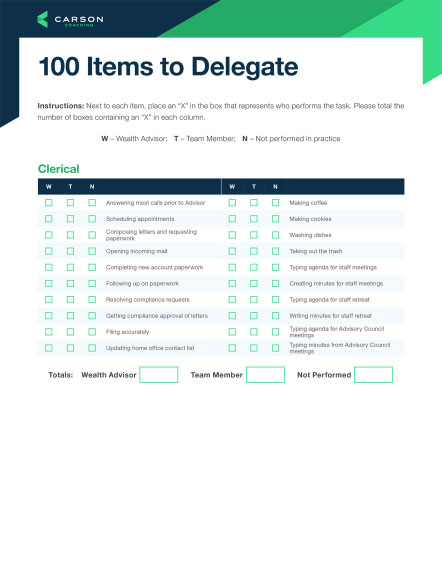“How are you going to top this experience” is a question Denise Sprung, Marketing Director for Mitlin Financial, frequently hears after events she organizes for clients.
She once organized a day at an NHL game for an A-plus client and her family, who are all hockey fans. She also organized an event at a local distillery for families to bond with the Mitlin team. No shop talk. No money talk. Just fun and connection.
There has rarely been a Carson Coaching team meeting in the past few months where I don’t recommend the book Unreasonable Hospitality: The Remarkable Power of Giving People More Than They Expect, by Will Guidara. And Denise Sprung engages in this type of “unreasonable hospitality” with Mitlin’s clients.
The premise of unreasonable hospitality is this: You should go above and beyond to give people more than they expect, you should personalize your client experience and you should create a culture within your team that makes them feel empowered to go the extra mile for clients.
And you, too, can create an amazing experience for your clients—one that wows them and makes them stay with you and refer you to others—and the tips in this blog post can help.
The Power of Getting to Know Your Clients
When Larry Sprung, Founder and Wealth Advisor at Mitlin Financial, sits down with clients for that first meeting, he doesn’t ask them to bring their bank statements or retirement account statements. He just wants to talk to them and get to know them.
This is key for the Mitlin Financial team—they get to know their clients and their values to be able to go above and beyond to deliver experiences that help them reach their financial goals and also provide them opportunities to have fun and connect with the team on an individual level.
Knowing what your clients are interested in, their goals and their likes and dislikes is critical to personalizing the experience for them.
The Framework for the Logistics
Atop the foundation of knowing your clients, you’ll need a frame for building your house of extraordinary client experiences. The steps I recommend are: (1) client segmentation; (2) big brainstorming; (3) realistic budget planning; (4) plan prioritization; (5) getting client feedback; and (6) ongoing input from your team.
Let’s get into each of these.
Client segmentation. One size doesn’t fit all in the financial advisory world. Recognizing this is the first step toward a remarkable client experience. Not every client needs everything you can do. Begin by segmenting your clients based on their needs, preferences, financial goals and profitability to your business (more on this next).
Big dream brainstorming. Next, brainstorm all the amazing services, value and resources you can provide your clients in each tier. Don’t hold back! And don’t (yet) worry about how much it will cost. Just think big. The more you expand your mind about all the ways you might serve your clients, the more potentially great ideas you’ll come up with!
Also, don’t hold yourself back during this brainstorming by asking, “Will compliance allow me to do this?” Just brainstorm! You can cross off ideas after if they aren’t feasible for any reason.
As an example, consider the following ideas:
- Have you thought about renting out a box at a local professional sports event?
- Have you thought about coordinating an around-the-world trip with your clients?
- Have you considered chartering a large fishing boat?
- Have you looked into bringing a professional therapist in-house?
- Can you have a golf simulator or coffee shop in your office for clients to enjoy while they wait for their meeting time?
Again, some of your ideas (or even the ideas listed above) might not be feasible from a financial or compliance perspective. But the point is to dream big—then you can get realistic. Because remember: The more ideas you brainstorm, the better the probability that one or more could be a game-changer for your client experience.
Always keep in mind that your client experience entails not just the actual advisory services you provide, but the entire spectrum of ways in which your clients engage and interact with you, your team and your company. Therefore, you should think of ideas in your brainstorming exercise related to client onboarding, review meetings, appreciation events, services and more.
Putting together a budget. At the end of the day, you’re still running a business here, so it’s vital to understand the profitability of every idea you execute and implement. The first step to knowing this is to look at your client tiers and evaluate the financial costs associated with each tier of client based on hours of your time, your team’s time, resources delivered, etc., to understand the revenue that each client generates for your business.
Once you know the revenue per client in each tier, and the cost to serve each client in each tier, you have an idea of the profitability per client. This isn’t an exact science—there’s not one specific formula that every firm uses. The key is to come up with a number you trust as reliable. World-renowned direct-response marketer Dan Kennedy is famous for saying, “Whoever can spend the most to acquire a client wins.” His point was that if you can outspend your competitors on advertising or running events that attract your ideal clients, then your competitors might find it difficult to compete.
Now, obviously, this has its limits, as clients can come to you or any other advisor in a multitude of ways. The point is, if you know how much profit you earn per client, you can figure out how much you can spend to acquire a client.
Although Dan’s quote is referring to acquiring a client, I mention it in this blog on creating a remarkable client experience because I’ve adapted the quote for retaining clients. You could also say, “Whoever can spend the most to retain a client will win.” If you can continually increase your revenue and profitability per client, you can invest more into your business to provide your clients with an outstanding, remarkable experience with you and your firm.
This is the point at which you can eliminate ideas that aren’t financially feasible based on your current profitability per client. Then, once you have a solid, reasonable, realistic list of ideas for how to improve your client experience, move onto the next step.
Prioritize your plan. Prioritize initiatives based on importance, feasibility and financial viability. Identify which initiatives can be executed in the current year and allocate resources accordingly. This step ensures a focused and realistic approach to delivering value. If you really made a great effort in the brainstorming process, you likely have several ideas that you could (at some point) implement. But you only have the resources, time, people and energy that you have today.
For example, if you came up with 100 legitimate, great ideas for improving your client experience, it would be a bit chaotic to ask your team and yourself to implement all 100 over the next few months. Instead, identify the ideas on the list that seem like they would make the biggest positive impact and could be implemented over the next few months.
Get client feedback. Instead of just guessing about what you think would make the biggest positive impact, ask the people who it will ultimately affect: your clients. Direct client feedback is invaluable. Host a Client Advisory Council to provide a platform for clients to express their needs and expectations directly. This forum not only demonstrates your commitment to delivering the best value possible to your clients, it also offers insights that might not be obvious from your or your team’s perspective. Listening to clients helps you customize your approach to meet their specific expectations.
An awesome tangential benefit to hosting a client advisory council is that it sets you up perfectly to ask your best clients for introductions to people they care about who you and your team could be serving, too.
Certainly, it’s important to get fresh ideas directly from your clients. But remember, this is also a place to get feedback on the ideas you already have from your clients. You can quickly identify which ideas your clients love and which they’re not as enthused by. Then, once you have solid ideas you’ve confirmed resonate with your clients, it’s time to set up to execute and implement.
Get perspective from your team. Encourage a culture of continuous improvement within your team. Inspire all team members to always ask, “How can we make this better for our clients?” This mindset sparks creativity and innovation, leading to ongoing enhancements in service delivery. If you and your team constantly have an eye on the “client experience,” you can be prepared to see new and better ways of serving your clients. And this mindset and attitude on your team could be the difference between growing at an OK pace and growing at an exciting, inspiring pace.
The Power of ‘Unreasonable Hospitality’
Can you think of a time when you had an extraordinary experience with a service provider? How did it make you feel? What specific elements made it so incredible? Exploring your own encounters with unreasonable hospitality could help you bring what you liked from those experiences into the ones you’re creating for your clients.
Creating a remarkable client experience is an ongoing journey that requires strategic planning, client engagement and a commitment to continuous improvement. By trying the steps in this blog post, you might be able to create an incredible, hospitable experience that keeps your clients coming back over and over again.
And when you start creating these amazing experiences, you might worry if you’ll be able to top them. But rest assured, we can help you. If you need support in this journey, get in touch with us.


